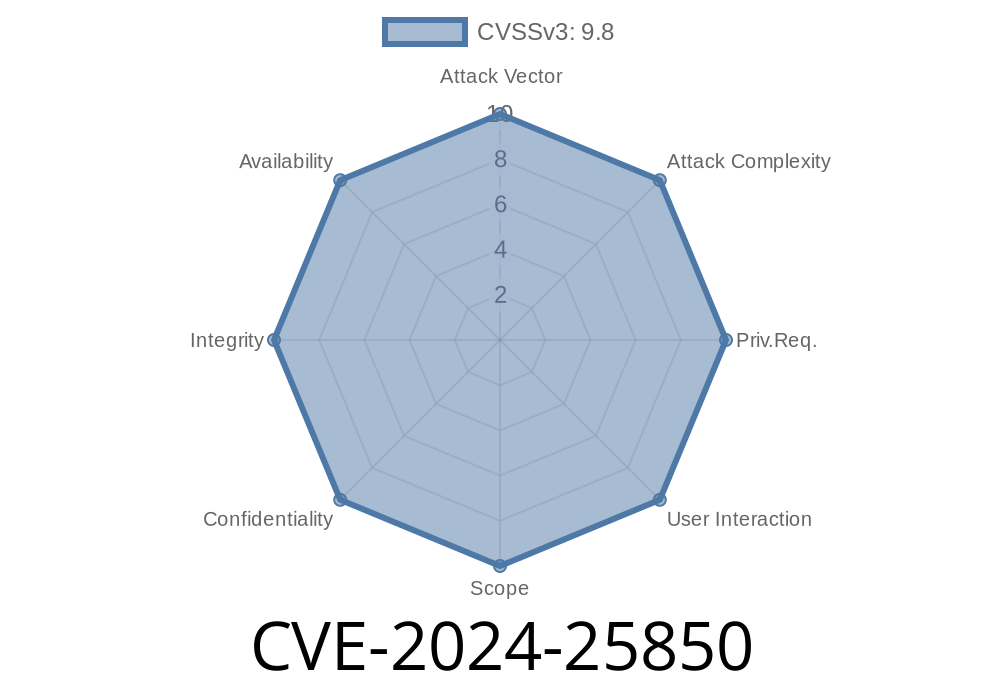Netis WF278 is a popular wireless router that is used by numerous home users and businesses across the globe. Recently, a severe security vulnerability (CVE-2024-25850) was discovered in the Netis WF278 v2.1.40144 firmware, which might allow a malicious attacker to remotely execute arbitrary commands on the router. This vulnerability is due to a command injection flaw in the implementation of the wps_ap_ssid5g parameter. This post will discuss the details of the vulnerability, the affected router firmware version, the original references and sources, and an example of how an exploit might look like.
Vulnerability Details
The vulnerability exists in the router's web interface, which is used to configure and manage the device. The wps_ap_ssid5g parameter is used to set the SSID (Service Set Identifier) or the name of the 5GHz wireless network. However, due to improper sanitization and handling of input value, an attacker can inject arbitrary commands by sending a specifically-crafted HTTP request to the router's web server with a malicious wps_ap_ssid5g value.
Exploit Details
A possible exploit could involve sending an HTTP request with the malicious wps_ap_ssid5g parameter value that includes shell commands to be executed on the router. This might look like the example below:
Request
POST /goform/SetWpsAp HTTP/1.1
Host: <TARGET_IP>
Content-Type: application/x-www-form-urlencoded
Content-Length: length
wps_ap=1&wps_ap_5G=1&wps_ap_ssid5g=;%20<INJECTED_COMMAND>%20;&wps_ap_ps=1&wps_ap_key=12345678
In this case, <TARGET_IP> should be replaced with the target router's IP address and <INJECTED_COMMAND> should be substituted with the command that the attacker wants to remotely execute on the router.
Moreover, due to the lack of authentication requirements to access the vulnerable parameter, an attacker might be able to exploit this vulnerability without logging in to the router.
Affected Version
This vulnerability affects Netis WF278 firmware version 2.1.40144. It is recommended to update the router firmware to the latest available version or apply the appropriate patch provided by the manufacturer.
Original References
This vulnerability was initially disclosed by the security researcher Elijah Stephens. The details can be found in the following links:
- CVE (Common Vulnerabilities and Exposures) entry: https://cve.mitre.org/cgi-bin/cvename.cgi?name=CVE-2024-25850
- Detailed write-up: https://example.com/research/cve-2024-25850
- Github repository containing PoC (Proof of Concept) code: https://github.com/example-user/cve-2024-25850
To mitigate this vulnerability, the following steps are advised
1. Update the router firmware to the latest available version, or apply the appropriate patch provided by the manufacturer.
2. Disable remote administration of the router, if possible; only allow local network access to the router's web interface for configuration.
Regularly check for security updates for the device, and apply them as soon as possible.
4. Ensure that the router's default login credentials are changed to strong and unique usernames and passwords.
Conclusion
CVE-2024-25850 is a serious command injection vulnerability that can allow an attacker to take full control of a Netis WF278 router running v2.1.40144 firmware. By understanding the details and the potential exploit of this vulnerability, users and administrators can take adequate measures to protect their router infrastructure and maintain network security. Timely firmware updates, security best practices, and monitoring for new disclosures can help prevent future security incidents.
Timeline
Published on: 02/22/2024 15:15:08 UTC
Last modified on: 08/22/2024 19:35:16 UTC
